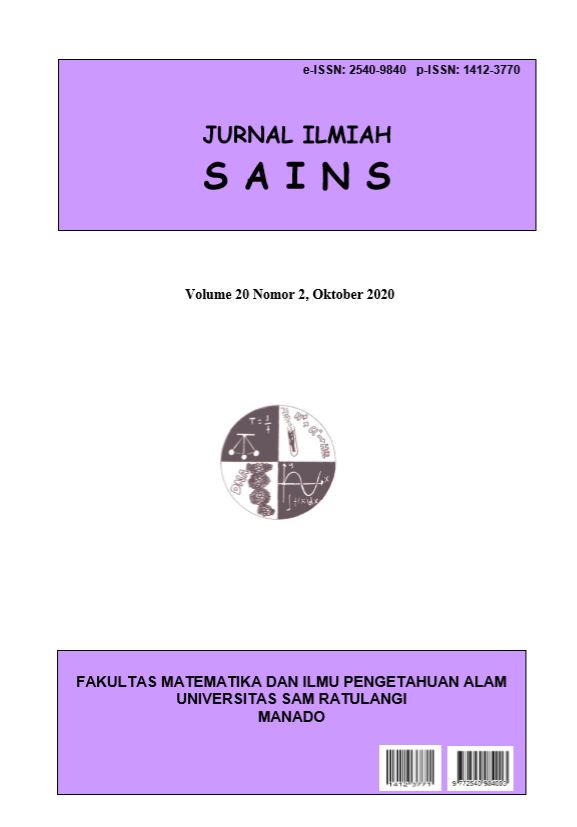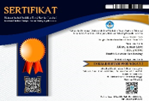Model Regresi Poisson Tergeneralisasi untuk Anak Gizi Buruk di Sulawesi Utara
DOI:
https://doi.org/10.35799/jis.20.2.2020.29133Abstract
Salah satu masalah kesehatan yang sering terjadi di Indonesia adalah gizi buruk. Seorang anak yang mengalami gizi buruk akan rentan terhadap berbagai penyakit karena sistem kekebalan tubuhnya mudah terinfeksi virus. Jumlah kasus anak gizi buruk merupakan data diskrit yÂÂang dapat dimodelkan dengan regresi poisson. Penelitian ini bertujuan untuk menentukan model regresi poisson tergeneralisasi dalam mengatasi overdispersi pada model regresi poisson dari jumlah kasus gizi buruk dan menentukan faktor-faktor yang mempengaruhi jumlah kasus gizi buruk di Sulawesi Utara tahun 2018. Data yang digunakan berupa jumlah kasus gizi buruk sebagai variabel respon dan sejumlah variabel prediktor dengan unit pengamatannya adalah kota dan kabupaten di Sulawesi Utara. Hasil penelitian menunjukkan bahwa variabel yang mempengaruhi jumlah anak gizi buruk di Sulawesi Utara adalah persentase bayi dengan berat badan lahir rendah (BBLR) dan variabel yang tidak berpengaruh signifikan adalah jumlah posyandu, persentase keluarga yang memiliki sanitasi layak pakai, jumlah penduduk miskin, persentase bayi yang menggunakan ASI ekslusif dengan model regresi poisson tergeneralisasi.
Kata kunci: Keluarga eksponensial; multikolinearitas; overdispersi; Sulawesi Utara
Generalized Poisson Regression Model For Malnourished Children in North Sulawesi
ABSTRACT
One of the health problems that often occurs in Indonesia is malnutrition. A child who is suffering from malnutrition will be vulnerable to various diseases because his immune system is easily infected by a virus. The number of cases of malnutrition children is discrete data that can be modeled by Poisson regression. This study aimed to determine the Generalized Poisson Regression (GPR) model for handling the overdispersion occurred in the Poisson regression model of the number of malnutrished children case and also to determine the factors that influence the number of malnutrished children case in North Sulawesi in 2018. This study utilizes the number of cases of malnutrition as a response variable and a number of predictor variables with the observation unit was cities and districts in North Sulawesi. The results of this study indicate that the variables that significantly affect the number of malnourished children in North Sulawesi include the percentage of child with low weight birth (LWB) and variables that have no significant effect are the number of posyandu, the percentage of families who have decent sanitation, the number of poor people, the percentage of babies who use exclusive breast milk with the generalized poisson regression model
Â
Keywords: Exponential family; multicolinearity; overdispersion; North Sulawesi
Salah satu masalah kesehatan yang sering terjadi di Indonesia adalah gizi buruk. Seorang anak yang mengalami gizi buruk akan rentan terhadap berbagai penyakit karena sistem kekebalan tubuhnya mudah terinfeksi virus. Jumlah kasus anak gizi buruk merupakan data diskrit yÂÂang dapat dimodelkan dengan regresi poisson. Penelitian ini bertujuan untuk menentukan model regresi poisson tergeneralisasi dalam mengatasi overdispersi pada model regresi poisson dari jumlah kasus gizi buruk dan menentukan faktor-faktor yang mempengaruhi jumlah kasus gizi buruk di Sulawesi Utara tahun 2018. Data yang digunakan berupa jumlah kasus gizi buruk sebagai variabel respon dan sejumlah variabel prediktor dengan unit pengamatannya adalah kota dan kabupaten di Sulawesi Utara. Hasil penelitian menunjukkan bahwa variabel yang mempengaruhi jumlah anak gizi buruk di Sulawesi Utara adalah persentase bayi dengan berat badan lahir rendah (BBLR) dan variabel yang tidak berpengaruh signifikan adalah jumlah posyandu, persentase keluarga yang memiliki sanitasi layak pakai, jumlah penduduk miskin, persentase bayi yang menggunakan ASI ekslusif dengan model regresi poisson tergeneralisasi .
Kata kunci: Keluarga eksponensial; multikolinearitas; overdispersi; Sulawesi Utara
Generalized Poisson Regression Model For Malnourished Children in North Sulawesi
Â
ABSTRACT
One of the health problems that often occurs in Indonesia is malnutrition. A child who is suffering from malnutrition will be vulnerable to various diseases because his immune system is easily infected by a virus. The number of cases of malnutrition children is discrete data that can be modeled by Poisson regression. This study aimed to determine the Generalized Poisson Regression (GPR) model for handling the overdispersion occurred in the Poisson regression model of the number of malnutrished children case and also to determine the factors that influence the number of malnutrished children case in North Sulawesi in 2018. This study utilizes the number of cases of malnutrition as a response variable and a number of predictor variables with the observation unit was cities and districts in North Sulawesi. The results of this study indicate that the variables that significantly affect the number of malnourished children in North Sulawesi include the percentage of child with low weight birth (LWB) and variables that have no significant effect are the number of posyandu, the percentage of families who have decent sanitation, the number of poor people, the percentage of babies who use exclusive breast milk with the generalized poisson regression model
 Keywords: Exponential family; multicolinearity; overdispersion; North Sulawesi
References
Agresti, A. 2006. An Introduction to Categorical Data Analysis: 2nd edition. In An Introduction to Categorical Data Analysis: Second Edition. https://doi.org/10.1002/0470114754.
BPS Provinsi Sulawesi Utara. 2019. Provinsi Sulawesi Utara Dalam Angka 2019.
BAPPENAS. 2006. Rencana Aksi Nasional Pangan dan Gizi 2006-2010.
Darwis, R.E., R. Majid & Ainurafiq. 2017. Analisis Determinan yang Berhubungan Dengan Kejadian Gizi Kurang Pada Balita Usia 12-59 Bulan di Wilayah Kerja Puskesmas Benu-Benua Kota Kendari Tahun 2017. Jurnal Ilmiah Mahasiswa Kesehatan Masyarakat, 2(6): 1-14.
Dobson, A.J. & A.G. Barnett. 2018. An Introduction to Generalized Linear Models 4th edition. CCRC Press, Taylor & Francis Group.
Famoye, F., J.T. Wulu & K. Singh. 2004. On the Generalized Poisson Regression Model with an Application to Accident Data. Journal of Data Science, 2(3): 287–295. https://doi.org/10.6339/JDS.2004.02(3).167
Hocking, R.R. 1996. Methods and Applications of Linear Models, 2nd edition. John Wiley and Sons Inc, New York.
Hosang, K.H., A. Umboh & H. Lestari. 2017. Hubungan Pemberian Makanan Tambahan Terhadap Perubahan Status Gizi Anak Balita Gizi Kurang di Kota Manado. Jurnal e-Clinic (eCl), 5(1): 1-5. https://doi.org/10.35790/ecl.5.1.2017 .14760.
Kumayas, V., Nancy S.H. Malonda & Maureen I. Punuh. 2019. Hubungan antara status imunisasi dan penyakit infeksi dengan status gizi pada balita usia 24-59 bulan di Desa Tateli Dua Kecamatan Mandolang, Kabupaten Minahasa. Jurnal KESMAS, 8(6): 299-305.
McCullagh, P. & J.A. Nelder. 1989. Generalized Linier Models, 2nd edition. Chapman and Hall, London.
Walpole, R. E. 1995. Pengantar Metode Statistika. PT Gramedia Pustaka Utama, Jakarta.
Walpole, R.E. 1995. Pengantar Metode Statistika. PT Gramedia Pustaka Utama, Jakarta.







